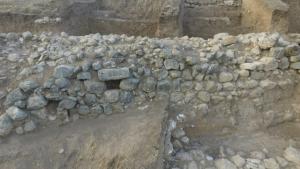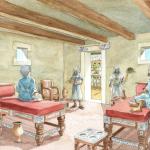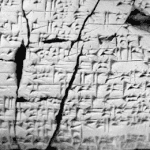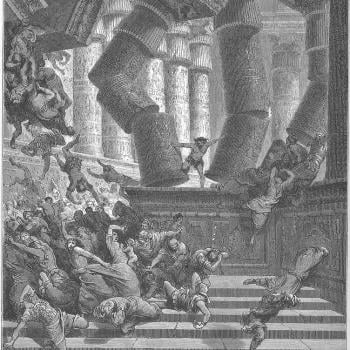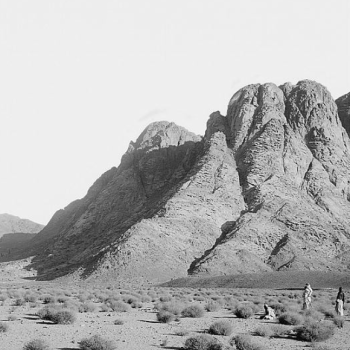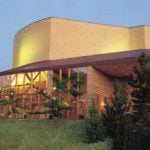Toi Staff reported on this exciting archaeological discovery in The Times of Israel: “Archaeologist: Thick wall found at Lachish indicates King Solomon’s son built it” (4-23-19):
Prof. Yosef Garfinkel, head of the Hebrew University of Jerusalem’s Institute of Archaeology, announced the find at a conference two weeks ago, . . .
The discovery, he argued, bolsters the biblical account in the book of Chronicles of the city under 10th century BCE King Rehoboam’s reign, . . .
“We looked in three places, and ultimately, in the northern section, we found a wall between Layer 6 and Layer 4. Later the excavators reached a floor that stretches to the wall, which could be dated using olive pits found beneath the floors. Samples of the pits were sent to the particle accelerator at Oxford, which ruled that the wall had been built around 920 B.C.E., which was exactly the rule of Rehoboam, son of Solomon and grandson of David.”
The discovery of a fortified city two days’ walk from King David and Solomon’s Jerusalem suggests the broader kingdom of Judah was established about a century earlier than historians currently believe.
This rather spectacularly verifies the Bible; especially this text:
2 Chronicles 11:5-12 (RSV) Rehobo’am dwelt in Jerusalem, and he built cities for defense in Judah. [6] He built Bethlehem, Etam, Teko’a, [7] Beth-zur, Soco, Adullam, [8] Gath, Mare’shah, Ziph, [9] Adora’im, Lachish, Aze’kah, [10] Zorah, Ai’jalon, and Hebron, fortified cities which are in Judah and in Benjamin. [11] He made the fortresses strong, and put commanders in them, and stores of food, oil, and wine. [12] And he put shields and spears in all the cities, and made them very strong. So he held Judah and Benjamin.
Encyclopaedia Britannica (“Kings: Solomon’s successors”) states that King Solomon died in 922 BC, succeeded by his son, Rehoboam. Note that the super-sophisticated “particle accelerator at Oxford” determined that the wall in Lachish was built around 920 BC: two years later. Bible and archaeology line up once again (I just wrote a book devoted to that convergence).
The prophet Jeremiah referred to Lachish (along with Azekah) as “the only fortified cities of Judah that remained” (Jer 34:7) shortly before the Babylonians conquered the country in 587-586 BC.
Archaeologists tell us that Lachish was in ruins for over 200 years. This is because Joshua took the city and burned it (Josh. 10:31-35). I wrote about it in my 2023 book, The Word Set in Stone (chapter: “Joshua and the Conquest of Canaan”):
The archaeological Level VII of Lachish has been dated to the thirteenth century B.C., and its destruction determined to be in the middle or latter part of the twelfth century B.C. According to Israeli archaeologist David Ussishkin, “the biblical description (in Josh. 10:31–32) fits the archaeological data: a large Canaanite city destroyed by fire . . . and complete desertion of the razed city explained by the annihilation of the populace.”
[Footnote: 3 Eero Junkkaala, Three Conquests of Canaan: A Comparative Study of Two Egyptian Military Campaigns and Joshua 10–12 in the Light of Recent Archaeological Evidence (Turku, Finland: Abo Akademi University Press, 2006); citations from pages 235–236, 238.]
Archaeologist Kenneth Kitchen dated the destruction of Lachish at “about 1177/1165” BC. [On the Reliability of the Old Testament (Grand Rapids and Cambridge: Wm. B. Eerdmans Publishing, 2003, p. 142)].
Avraham Negev and Shimon Gibson, editors of Archaeological Encyclopedia of the Holy Land (New York: Continuum, revised edition of 2001, “Lachish,” 289) describe other findings in Lachish which are also consistent with the biblical accounts:
The earliest Israelite remains are the foundations of a palace (Palace A). It is 100 feet square and . . . is attributed to Rehoboam (928-911 BC). To the time of Asa (908-867 BC, stratum IV) is attributed the building of a city wall . . . To the time of Jehoshaphat (867-846 BC) is attributed the enlargement of the fortified palace . . .
***
Further Related Reading
My book, The Word Set in Stone: How Archaeology, Science, and History Back up the Bible (Catholic Answers Press, March 2023)
***
Practical Matters: Perhaps some of my 4,000+ free online articles (the most comprehensive “one-stop” Catholic apologetics site) or fifty books have helped you (by God’s grace) to decide to become Catholic or to return to the Church, or better understand some doctrines and why we believe them.
Or you may believe my work is worthy to support for the purpose of apologetics and evangelism in general. If so, please seriously consider a much-needed financial contribution. I’m always in need of more funds: especially monthly support. “The laborer is worthy of his wages” (1 Tim 5:18, NKJV). 1 December 2021 was my 20th anniversary as a full-time Catholic apologist, and February 2022 marked the 25th anniversary of my blog.
PayPal donations are the easiest: just send to my email address: [email protected]. You’ll see the term “Catholic Used Book Service”, which is my old side-business. To learn about the different methods of contributing, including 100% tax deduction, etc., see my page: About Catholic Apologist Dave Armstrong / Donation Information. Thanks a million from the bottom of my heart!
***
Photo credit: [אמיל אלגם / Bible Archaeology Report]
***
Summary: In 2019, archaeologists discovered King Rehoboam’s wall in Lachish in Israel, dated to c. 920 BC in a “fortified city”: precisely the place & period described in the Bible.


